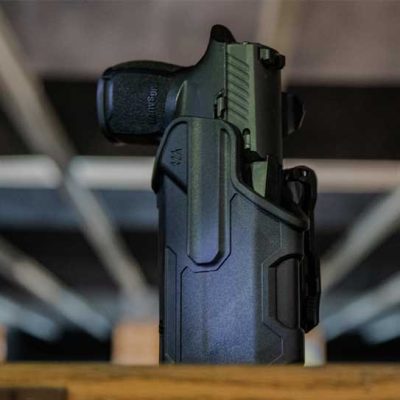By Robert Sadowski

When the S&W M&P 9 Shield was first introduced in 2012, a lot of shooters were on a sugar high with polymer-framed, striker-fire handguns. Another pistol manufacturer was introducing a plastic striker-fire. Then, shooters started getting their hands on these guns at the range.
It wasn’t long before folks realized the benefits of this particular striker-fired pistol. The Shield came with a wide trigger that broke cleaner than other striker-fired guns. It was also smaller, lighter and more compact than most other Smith & Wesson pistols. And for many people, its 18-degree grip angle was extremely comfortable to hold and shoot, and shoot well.
My first time shooting the Shield in 9mm I punched a golf ball sized hole into the center of mass at 5 yards. The instructor yelled, “Aim for the head.”
I did what he said, and the Shield led the way. Ever since the S&W Shield has been the handgun I most consistently carry concealed. Sure, I cheat on the Shield with other new compact nines, but I always come back to the Shield. I didn’t choose the gun, the gun chose me.
S&W Downsized to Create the Shield
Back in 2012 S&W’s M&P pistols were making shooters think there were better polymer-framed, striker-fire pistols. While those M&Ps were full-size service pistols, the company designed the Shield to be thinner and lighter. The perfect combination for a concealed-carry pistol.
Original Shield models were offered in 9mm and .40 Auto. With a 3.1-inch barrel, the overall length was 6.1 inches. Unloaded it weighed 19 ounces. And it was slightly less than 1-inch wide. The narrow slide and frame was due to the thinner magazine.
The Shield does not use a double-stack magazine like full size M&Ps. The Shield uses a magazine that is about a cartridge and half wide and narrows to a single stack at the top. This magazine design provided a higher magazine capacity than a traditional single stack. Two magazine were offered; a 7-round flush fit and an extended 8-round in 9mm guns.
Simple To Operate
The Shield incorporated a dual-recoil spring setup, so recoil was less snappy and easy to control. Probably the features that sold me on the Shield was the simplicity of the pistol. Just a small slide stop, take down lever and magazine release. You could get them with a manual safety, and you still can, but the articulating trigger incorporates a safety lever. The lower hinged part of the triggers acts like a trigger safety. Mine has a safety and I don’t think I have ever used it. Sights were made of steel and used the then-common three white dots.
The first Shield was not just a downsized M&P. It has a refined design. Shooters liked nearly everything about the S&W compact. It was slim, light, simple to operate, reliable, and chambered in potent and popular defensive calibers. Popularity and demand for the Shield was high and S&W listened to their customers to enhance and evolve the line.
S&W Shield M2.0
By 2018 S&W was evolving the M&P series and introduced the M2.0 generation. The Shield followed suit, with a new grip texture offering better adhesion without abrasion.
The company also added scalloped slide serrations at the muzzle for easier press checks, and placed the trigger stop higher up. The serrations and trigger modifications followed new trends in handgun training that were developing at the time.
The trigger stop limits over travel and reset. Newer Shields M2.0 have a tactile and audible trigger reset. Some variants of M2.0 Shields wear fiber-optic sights that are a big step up over the tradition three-dot sights.
Tweaking the Shield
S&W’s Performance Center got a hold of the Shield and ported it to reduce muzzle flip. It also added a longer 4-inch barrel variant and made some optic ready. The trigger was refined, too.
Later, as stack-and-half 9mm pistols became more popular, S&W responded with the Shield Plus in 2021. This is the same Shield, but with a 10-round, flush-fit magazine or an extended 13-round magazine. Even with the higher capacity magazine the Shield keep its lithe shape. Total width of the Shield increased to 1.1 inches.
The Shield Plus also received a flat-face trigger for consistent finger placement. Shooters like flat-face triggers because they allow for more accurate and repeatable shooting. Caliber choices in the Plus size Shield include 9mm, .40 Auto and .45 Auto.
Now, if there a downside to running compact pistols, it is manipulating the slide. Users need hand strength to rack the slide. The Shield EZ combats this by featuring easy-to-rack slides, along with magazines that are easier to load and seat. The EZ also incorporates a grip safety, which is another layer of safety to passive safeties. Shield EZ pistols come in .380 Auto, 9mm and the newer .30 Super Carry.
Are S&W Shields Worth It?
For those in the market for a concealed-carry handgun, the S&W Shield offers performance driven options, from slim 2M.0 models and high capacity Plus models to easy-to-operate EZ models and even tricked out semi-custom guns from the Performance Center.
The S&W Shield has helped redefine the compact 9mm, and over the years has been refined to keep up with the features shooter demand. Not only are these guns reliable, they are affordable and made in the USA.











